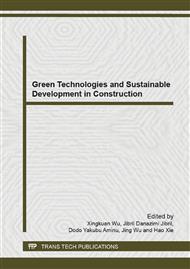[1]
Satish Totey; KaushikD. Deb: Stem Cell Techmologies, Basics and Applications LIST OF CONTRIBUTORS. STEM CELL AND REGENERATIVE MEDICINE – THE EVOLVING STORY, Access Engineering.
Google Scholar
[2]
Eugene A. Avallone; Theodore Baumeister III; Ali Sadegh, Marks' Standard Handbook for Mechanical Engineers, Eleventh Edition Contributors. INTRODUCTION TO NANOTECHNOLOGY, AccessEngineering.
Google Scholar
[3]
Joseph H. Koo, Polymer Nanocomposites: Processing, Characterization, and Applications. Introduction, Chapter(2006), AccessEngineering.
Google Scholar
[4]
Rahel KH. Ibrahim, Roszilah HAMID, Mohd Raihan TAHA, NANOMATERIALS IN CONCRETE, pg 228, Department of Civil and Structural Engineering, Faculty of Engineering and Built Environment, Universiti Kebangsaan Malaysia.
DOI: 10.17576/jkukm-2022-34(6)-17
Google Scholar
[5]
Teizer, J. Venugopal, M. Teizer, W. and Felkl, J., Nanotechnology and Its Impact On Construction: Bridging the Gap Between Researchers and Industry Professionals. Journal of Construction Engineering and Management, 138, pp.594-604.
DOI: 10.1061/(asce)co.1943-7862.0000467
Google Scholar
[6]
Teizer, J. Venugopal, M. Teizer, W. and Felkl, J., Nanotechnology and Its Impact On Construction: Bridging the Gap Between Researchers and Industry Professionals. Journal of Construction Engineering and Management, 138, pp.594-604.
DOI: 10.1061/(asce)co.1943-7862.0000467
Google Scholar
[7]
Teizer, J. Venugopal, M. Teizer, W. and Felkl, J., Nanotechnology and Its Impact On Construction: Bridging the Gap Between Researchers and Industry Professionals. Journal of Construction Engineering and Management, 138, pp.594-604.
DOI: 10.1061/(asce)co.1943-7862.0000467
Google Scholar
[8]
Rahel KH. Ibrahim, Roszilah HAMID, Mohd Raihan TAHA: NANOMATERIALS IN CONCRETE, pg 225, Department of Civil and Structural Engineering, Faculty of Engineering and Built Environment, Universiti Kebangsaan Malaysia.
DOI: 10.17576/jkukm-2022-34(6)-17
Google Scholar
[9]
Vaidya, S. , Montes, C. , and Allouche,E. N, Use of Nanomaterials for Concrete Pipe Protection, 2007, American Society of Civil Engineers.
DOI: 10.1061/40934(252)100
Google Scholar
[10]
Tyson, B. Abu Al-Rub, R. Yazdanbakhsh, A. and Grasley, Z., Carbon Nanotubes and Carbon Nanofibers for Enhancing the Mechanical Properties of NanocompositeCementitious Materials. Journal of Materials in Civil Engineering, 23, pp.1028-1035.
DOI: 10.1061/(asce)mt.1943-5533.0000266
Google Scholar
[11]
F. Abe, M. Taneike, K. Sawada., Alloy design of creep resistant 9Cr steel using a dispersion of nano sized carbonitrides. International Journal of Pressure Vessels and Piping, 84, pp.3-12.
DOI: 10.1016/j.ijpvp.2006.09.003
Google Scholar
[12]
S.K. Karak, T. Chuudoba, Z. Witczak, W. Lojkowski, I. Manna., Development of ultra high strength nano-Y2O3 dispersed ferritic steel by mechanical alloying and hot isostatic pressing. Materials Science and Engineering, 528, pp.7475-7483.
DOI: 10.1016/j.msea.2011.06.039
Google Scholar
[13]
Y.L. Kang, Q.H. Han, X.M. Zhao, M.H. Cai., Influence of nanoparticle reinforcements on the strengthening mechanisms of an ultrafine-grained dual phase steel containing titanium. Materials & Design, 44, pp.331-339.
DOI: 10.1016/j.matdes.2012.07.068
Google Scholar
[14]
Z. Wang, H. Dai, Y. Zou., Effects of nanoTiN addition on the microstructure and mechanical properties of TiC based steel bonded carbides. Rare Metals, 27, pp.5-8.
DOI: 10.1016/s1001-0521(08)60019-4
Google Scholar
[15]
J.P. Won, Y.N. Yoon, B.T. Hong, T.J. Choi, S.J. Lee., Durability characteristics of nano-GFRP composite reinforcing bars for concrete structures in moist and alkaline environments. Composite Structures, 94, pp.1236-1242.
DOI: 10.1016/j.compstruct.2011.11.006
Google Scholar
[16]
Z. Zhang, J. McMullen, H. N. Dhakal, J. Radulovic, C. Herodotou, M. Totomis, N. Benett., Enhanced water repellence and thermal insulation of masonry by zinc oxide treatment. Energy and Buildings, 54, pp.40-46.
DOI: 10.1016/j.enbuild.2012.07.030
Google Scholar
[17]
D. Haldane., More than drop in the bucket. Los Angeles Business Journal.
Google Scholar
[18]
Q. Li,S. Mahendra, D.Y. Lyon, L. Brunet, M. V. Liga, D. Li, P. J.J. Alvarez., Antimicrobial nanomaterials for water disinfection andmicrobial control: potential applications and implications, Water Research, 42, pp.4591-4602.
DOI: 10.1016/j.watres.2008.08.015
Google Scholar
[19]
S. Syed., M.I. Alhazzaa, M. Asif., Treatment of oily water using hydrophobic nano silica. Chemical Engineering Journal, 16, pp.99-103.
DOI: 10.1016/j.cej.2010.12.006
Google Scholar
[20]
L. Senff, D. Hotza, S. Lucas, B.M. Ferreira, J.A. Labrincha., Effect of nano-SiO2 and nano-TiO2 addition on the rheological behavior and the hardened properties of cement mortars. Material Science and Engineering, 532, 354.
DOI: 10.1016/j.msea.2011.10.102
Google Scholar
[21]
H. Li, H. Xiao, J. Yuan, J. Yuan, J. Ou., Microstructure of cement mortar with nano-particles. Composites: Part B, 35, 185.
DOI: 10.1016/s1359-8368(03)00052-0
Google Scholar
[22]
C. Bertolini, A. Crivellaro, M. Marciniak, T. Marzi, M. Socha., Nanostructured Materials for Durability and Restoration of Wooden Surfaces in Architecture and Civil Engineering. World Conference on Timber Engineering, p.3.
Google Scholar


